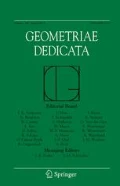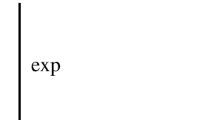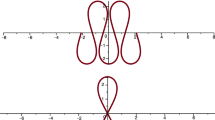Abstract
The purpose of this note is to study configurations of lines in projective planes over arbitrary fields having the maximal number of intersection points where three lines meet. We give precise conditions on ground fields \(\mathbb F\) over which such extremal configurations exist. We show that there does not exist a field admitting a configuration of 11 lines with 17 triple points, even though such a configuration is allowed combinatorially. Finally, we present an infinite series of configurations which have a high number of triple intersection points.









Similar content being viewed by others
References
Amram, M., Cohen, M., Teicher, M., Ye, F.: Moduli spaces of ten-line arrangements with double and triple points, arXiv:1306.6105
Amram, M., Teicher, M., Ye, F.: Moduli spaces of arrangements of 10 projective lines with quadruple points. Adv. Appl. Math. 51, 392–418 (2013)
Arnol’d, V.I.: Simple singularities of curves. Tr. Mat. Inst. Steklova 226, 27–35 (1999)
Artebani, M., Dolgachev, I.: The Hesse pencil of plane cubic curves. L’Enseignement Mathématique. Revue Internationale. 2e Série 55, 235–273 (2009)
Bauer, Th., Di Rocco, S., Harbourne, B., Huizenga, J., Lundman, A., Pokora, P., Szemberg, T.: Bounded negativity and arrangements of lines. Int. Math. Res. Not. (2014). doi:10.1093/imrn/RNU236
Bokowski, J., Pilaud, V.: Enumerating topological \((n_k)\)-configurations. Comput. Geom. 47(2, part A), 175–186 (2014)
Bokowski, J., Schewe, L.: On the finite set of missing geometric configurations \((n_4)\). Comput. Geom. 46, 532–540 (2013)
Burr, S.A., Grünbaum, B., Sloane, N.J.A.: The orchard problem. Geom. Dedicata 2, 397–424 (1974)
Decker, W., Greuel, G.-M., Pfister, G., Schönemann, H.: Singular 3-1-3—a computer algebra system for polynomial computations. http://www.singular.uni-kl.de (2011)
Dumnicki, M., Szemberg, T., Tutaj-Gasińska, H.: Counterexamples to the \(I^{(3)}\subset I^2\) containment. J. Algebra 393, 24–29 (2013)
Geramita, A.V., Harbourne, B., Migliore, J.: Star configurations in \({\mathbb{P}}^n\). J. Algebra 376, 279–299 (2013)
Glynn, D.: On the Anti-Pappian \(10_3\) and its construction. Geom. Dedicata 77, 71–75 (1999)
Green, B., Tao, T.: On sets defining few ordinary lines. Discrete Comput. Geom. 50, 409–468 (2013)
Grünbaum, B.: Configurations of Points and Lines. Graduate Studies in Mathematics, vol. 103. American Mathematical Society, Providence (2009)
Harbourne, B., Szemberg, T.: Arrangements of lines. Snapshots of modern mathematics from Oberwolfach 11/2014. doi:10.14760/SNAP-2014-011-EN
Kirkman, T.P.: On a problem in combinations. Camb. Dublin Math. J. 2, 191–204 (1847)
Langer, A.: Logarithmic orbifold Euler numbers of surfaces with applications. Proc. Lond. Math. Soc. 86(3), 358–396 (2003)
Lauffer, R.: Die nichtkonstruierbare Konfiguration \((10_3)\). Math. Nachr. 11, 303–304 (1954)
Ran, Z.: On nodal plane curves. Invent. Math. 86, 529–534 (1986)
Schönheim, J.: On maximal systems of k-tuples. Stud. Sci. Math. Hung. 1, 363–368 (1966)
Sturmfels, B.: Computational algebraic geometry of projective configurations. Invariant-theoretic algorithms in geometry (Minneapolis, MN, 1987). J. Symb. Comput. 11, 595–618 (1991)
Teitler, Z.: Multiplier ideals of general line arrangements in \({\mathbb{C}}^3\). Comm. Algebra 35, 1902–1913 (2007)
Acknowledgments
This notes originated in a workshop on Arrangements of Lines held in Lanckorona in April 2014. We thank the Jagiellonian University in Cracow for financial support. We thank also Brian Harbourne and Witold Jarnicki for helpful discussions. We are grateful to the referee for remarks which led to considerable improvements of the final version of this paper.
Author information
Authors and Affiliations
Corresponding author
Additional information
M.D., T.S., J.S. and H.TG were partially supported by the National Science Centre, Poland, Grant 2014/15/B/ST1/02197.
Rights and permissions
About this article
Cite this article
Dumnicki, M., Farnik, Ł., Główka, A. et al. Line arrangements with the maximal number of triple points. Geom Dedicata 180, 69–83 (2016). https://doi.org/10.1007/s10711-015-0091-7
Received:
Accepted:
Published:
Issue Date:
DOI: https://doi.org/10.1007/s10711-015-0091-7




